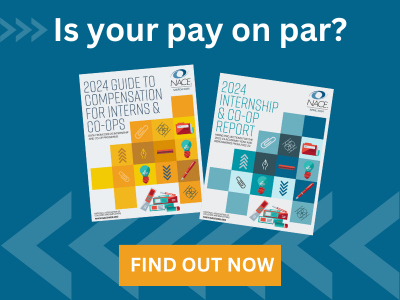Spotlight for Career Services Professionals
Among organizations that planned to maintain their summer 2020 internship program in April, more than half indicated that they were moving their programs to a virtual space in response to the coronavirus pandemic, according to NACE Report: COVID-19 Quick Poll Series.
The largest organizations were most likely to make this change. By the end of April, nearly three-quarters of respondents with more than 20,000 employees expected to move their summer 2020 internship programs to virtual. (See Figure 1.)
More than 60% of employers with 5,001 to 20,000 employers also transitioned their internship programs to virtual; interestingly, the same was true for employers with 500 or fewer employees.
Meanwhile, small to medium companies were more likely to reduce the length of the internship by delaying start date, which was the second most popular adaptation employers made to their summer 2020 internship programs.
NACE conducted a series of monthly coronavirus quick polls—from March through June 2020—to assess the impact on and response from colleges and employers in our field. The four quick polls addressed a variety of topics, including office closures, travel restrictions, internships, plans for fall recruiting, on-campus activities, changes in budgets and staffing, revoked offers, delayed start dates, virtual onboarding, and changes in service provision. Download the report here.
Figure 1: Adaptations to Summer 2020 Internship Programs, by Company Size
| Adaptations | |
|---|---|
| Moved interns to a virtual program | |
| Overall | 54.8% |
| 500 or Fewer | 61.3% |
| 501 to 1,000 | 28.6% |
| 1,001 to 2,500 | 58.1% |
| 2,501 to 5,000 | 42.2% |
| 5,001 to 10,000 | 62.2% |
| 10,001 to 20,000 | 65.7% |
| More than 20,000 | 71.2% |
| Reduced the length of the internship by delaying start date | |
| Overall | 48.7% |
| 500 or Fewer | 51.6% |
| 501 to 1,000 | 47.6% |
| 1,001 to 2,500 | 51.6% |
| 2,501 to 5,000 | 60.0% |
| 5,001 to 10,000 | 53.3% |
| 10,001 to 20,000 | 48.6% |
| More than 20,000 | 47.9% |
| Moved events online such as end of program project presentations | |
| Overall | 29.7% |
| 500 or Fewer | 32.3% |
| 501 to 1,000 | 28.6% |
| 1,001 to 2,500 | 32.3% |
| 2,501 to 5,000 | 31.1% |
| 5,001 to 10,000 | 40.0% |
| 10,001 to 20,000 | 40.0% |
| More than 20,000 | 31.5% |
| Reduced the number of interns we are onboarding | |
| Overall | 25.1% |
| 500 or Fewer | 19.4% |
| 501 to 1,000 | 28.6% |
| 1,001 to 2,500 | 19.4% |
| 2,501 to 5,000 | 31.1% |
| 5,001 to 10,000 | 35.6% |
| 10,001 to 20,000 | 28.6% |
| More than 20,000 | 21.9% |
| No changes | |
| Overall | 19.9% |
| 500 or Fewer | 25.8% |
| 501 to 1,000 | 23.8% |
| 1,001 to 2,500 | 19.4% |
| 2,501 to 5,000 | 24.4% |
| 5,001 to 10,000 | 13.3% |
| 10,001 to 20,000 | 17.1% |
| More than 20,000 | 12.3% |
| Adaptations | Overall | 500 or Fewer | 501 to 1,000 | 1,001 to 2,500 | 2,501 to 5,000 | 5,001 to 10,000 | 10,001 to 20,000 | More than 20,000 |
|---|---|---|---|---|---|---|---|---|
| Moved interns to a virtual program | 54.8% | 61.3% | 28.6% | 58.1% | 42.2% | 62.2% | 65.7% | 71.2% |
| Reduced the length of the internship by delaying start date | 48.7% | 51.6% | 47.6% | 51.6% | 60.0% | 53.3% | 48.6% | 47.9% |
| Moved events online such as end of program project presentations | 29.7% | 32.3% | 28.6% | 32.3% | 31.1% | 40.0% | 40.0% | 31.5% |
| Reduced the number of interns we are onboarding | 25.1% | 19.4% | 28.6% | 19.4% | 31.1% | 35.6% | 28.6% | 21.9% |
| No changes | 19.9% | 25.8% | 23.8% | 19.4% | 24.4% | 13.3% | 17.1% | 12.3% |






